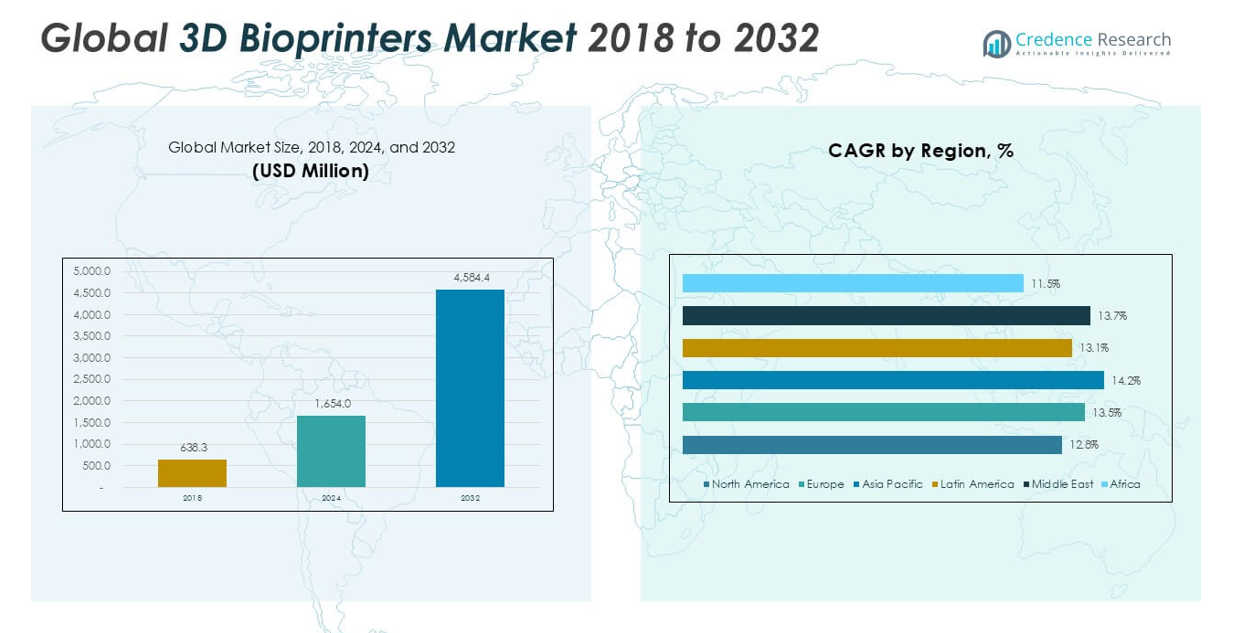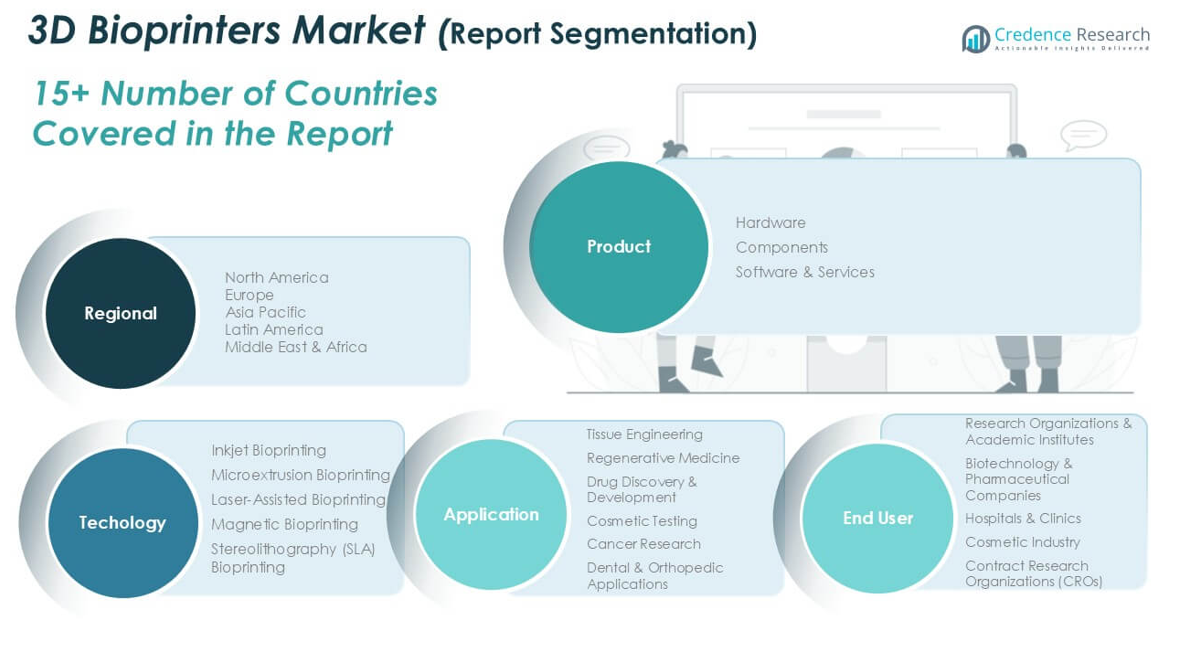CHAPTER NO. 1 : GENESIS OF THE MARKET
1.1 Market Prelude – Introduction & Scope
1.2 The Big Picture – Objectives & Vision
1.3 Strategic Edge – Unique Value Proposition
1.4 Stakeholder Compass – Key Beneficiaries
CHAPTER NO. 2 : EXECUTIVE LENS
2.1 Pulse of the Industry – Market Snapshot
2.2 Growth Arc – Revenue Projections (USD Million)
2.3. Premium Insights – Based on Primary Interviews
CHAPTER NO. 3 : 3D BIOPRINTERS MARKET FORCES & INDUSTRY PULSE
3.1 Foundations of Change – Market Overview
3.2 Catalysts of Expansion – Key Market Drivers
3.2.1 Momentum Boosters – Growth Triggers
3.2.2 Innovation Fuel – Disruptive Technologies
3.3 Headwinds & Crosswinds – Market Restraints
3.3.1 Regulatory Tides – Compliance Challenges
3.3.2 Economic Frictions – Inflationary Pressures
3.4 Untapped Horizons – Growth Potential & Opportunities
3.5 Strategic Navigation – Industry Frameworks
3.5.1 Market Equilibrium – Porter’s Five Forces
3.5.2 Ecosystem Dynamics – Value Chain Analysis
3.5.3 Macro Forces – PESTEL Breakdown
CHAPTER NO. 4 : KEY INVESTMENT EPICENTER
4.1 Regional Goldmines – High-Growth Geographies
4.2 Product Frontiers – Lucrative Product Categories
4.3 Product Sweet Spots – Emerging Demand Segments
CHAPTER NO. 5: REVENUE TRAJECTORY & WEALTH MAPPING
5.1 Momentum Metrics – Forecast & Growth Curves
5.2 Regional Revenue Footprint – Market Share Insights
5.3 Segmental Wealth Flow – Product, Technology, Application & End User Revenue
CHAPTER NO. 6 : TRADE & COMMERCE ANALYSIS
6.1. Import Analysis By Region
6.1.1. Global 3D Bioprinters Market Import Revenue By Region
6.2. Export Analysis By Region
6.2.1. Global 3D Bioprinters Market Export Revenue By Region
CHAPTER NO. 7 : COMPETITION ANALYSIS
7.1. Company Market Share Analysis
7.1.1. Global 3D Bioprinters Market: Company Market Share
7.2. Global 3D Bioprinters Market Company Revenue Market Share
7.3. Strategic Developments
7.3.1. Acquisitions & Mergers
7.3.2. New Type of 3D Bioprinters Launch
7.3.3. Regional Expansion
7.4. Competitive Dashboard
7.5. Company Assessment Metrics, 2024
CHAPTER NO. 8 : 3D BIOPRINTERS MARKET – BY PRODUCT SEGMENT ANALYSIS
8.1. 3D Bioprinters Market Overview By Product Segment
8.1.1. 3D Bioprinters Market Revenue Share By Product
8.2. Hardware
8.3. Components
CHAPTER NO. 9 : 3D BIOPRINTERS MARKET – BY TECHNOLOGY SEGMENT ANALYSIS
9.1. 3D Bioprinters Market Overview By Technology Segment
9.1.1. 3D Bioprinters Market Revenue Share By Technology
9.2. Inkjet Bioprinting
9.3. Microextrusion Bioprinting
9.4. Laser-Assisted Bioprinting
9.5. Magnetic Bioprinting
9.6. Stereolithography (SLA) Bioprinting
CHAPTER NO. 10 : 3D BIOPRINTERS MARKET – BY APPLICATION SEGMENT ANALYSIS
10.1. 3D Bioprinters Market Overview By Application Segment
10.1.1. 3D Bioprinters Market Revenue Share By Application
10.2. Tissue Engineering
10.3. Regenerative Medicine
10.4. Drug Discovery & Development
10.5. Cosmetic Testing
10.6. Cancer Research
10.7. Dental & Orthopedic Applications
CHAPTER NO. 11 : 3D BIOPRINTERS MARKET – BY END USER SEGMENT ANALYSIS
11.1. 3D Bioprinters Market Overview By End User Segment
11.1.1. 3D Bioprinters Market Revenue Share By End User
11.2. Research Organizations & Academic Institutes
11.3. Biotechnology & Pharmaceutical Companies
11.4. Hospitals & Clinics
11.5. Cosmetic Industry
11.6. Contract Research Organizations (CROs)
CHAPTER NO. 12 : 3D BIOPRINTERS MARKET – REGIONAL ANALYSIS
12.1. 3D Bioprinters Market Overview By Region Segment
12.1.1. Global 3D Bioprinters Market Revenue Share By Region
12.1.2. Regions
12.1.3. Global 3D Bioprinters Market Revenue By Region
12.1.4. Product
12.1.5. Global 3D Bioprinters Market Revenue By Product
12.1.6. Technology
12.1.7. Global 3D Bioprinters Market Revenue By Technology
12.1.8. Application
12.1.9. Global 3D Bioprinters Market Revenue By Application
12.1.10. End User
12.1.11. Global 3D Bioprinters Market Revenue By End User
CHAPTER NO. 13 : NORTH AMERICA 3D BIOPRINTERS MARKET – COUNTRY ANALYSIS
13.1. North America 3D Bioprinters Market Overview By Country Segment
13.1.1. North America 3D Bioprinters Market Revenue Share By Region
13.2. North America
13.2.1. North America 3D Bioprinters Market Revenue By Country
13.2.2. Product
13.2.3. North America 3D Bioprinters Market Revenue By Product
13.2.4. Technology
13.2.5. North America 3D Bioprinters Market Revenue By Technology
13.2.6. Application
13.2.7. North America 3D Bioprinters Market Revenue By Application
13.2.8. End User
13.2.9. North America 3D Bioprinters Market Revenue By End User
13.3. U.S.
13.4. Canada
13.5. Mexico
CHAPTER NO. 14 : EUROPE 3D BIOPRINTERS MARKET – COUNTRY ANALYSIS
14.1. Europe 3D Bioprinters Market Overview By Country Segment
14.1.1. Europe 3D Bioprinters Market Revenue Share By Region
14.2. Europe
14.2.1. Europe 3D Bioprinters Market Revenue By Country
14.2.2. Product
14.2.3. Europe 3D Bioprinters Market Revenue By Product
14.2.4. Technology
14.2.5. Europe 3D Bioprinters Market Revenue By Technology
14.2.6. Application
14.2.7. Europe 3D Bioprinters Market Revenue By Application
14.2.8. End User
14.2.9. Europe 3D Bioprinters Market Revenue By End User
14.3. UK
14.4. France
14.5. Germany
14.6. Italy
14.7. Spain
14.8. Russia
14.9. Rest of Europe
CHAPTER NO. 15 : ASIA PACIFIC 3D BIOPRINTERS MARKET – COUNTRY ANALYSIS
15.1. Asia Pacific 3D Bioprinters Market Overview By Country Segment
15.1.1. Asia Pacific 3D Bioprinters Market Revenue Share By Region
15.2. Asia Pacific
15.2.1. Asia Pacific 3D Bioprinters Market Revenue By Country
15.2.2. Product
15.2.3. Asia Pacific 3D Bioprinters Market Revenue By Product
15.2.4. Technology
15.2.5. Asia Pacific 3D Bioprinters Market Revenue By Technology
15.2.6. Application
15.2.7. Asia Pacific 3D Bioprinters Market Revenue By Application
15.2.8. End User
15.2.9. Asia Pacific 3D Bioprinters Market Revenue By End User
15.3. China
15.4. Japan
15.5. South Korea
15.6. India
15.7. Australia
15.8. Southeast Asia
15.9. Rest of Asia Pacific
CHAPTER NO. 16 : LATIN AMERICA 3D BIOPRINTERS MARKET – COUNTRY ANALYSIS
16.1. Latin America 3D Bioprinters Market Overview By Country Segment
16.1.1. Latin America 3D Bioprinters Market Revenue Share By Region
16.2. Latin America
16.2.1. Latin America 3D Bioprinters Market Revenue By Country
16.2.2. Product
16.2.3. Latin America 3D Bioprinters Market Revenue By Product
16.2.4. Technology
16.2.5. Latin America 3D Bioprinters Market Revenue By Technology
16.2.6. Application
16.2.7. Latin America 3D Bioprinters Market Revenue By Application
16.2.8. End User
16.2.9. Latin America 3D Bioprinters Market Revenue By End User
16.3. Brazil
16.4. Argentina
16.5. Rest of Latin America
CHAPTER NO. 17 : MIDDLE EAST 3D BIOPRINTERS MARKET – COUNTRY ANALYSIS
17.1. Middle East 3D Bioprinters Market Overview By Country Segment
17.1.1. Middle East 3D Bioprinters Market Revenue Share By Region
17.2. Middle East
17.2.1. Middle East 3D Bioprinters Market Revenue By Country
17.2.2. Product
17.2.3. Middle East 3D Bioprinters Market Revenue By Product
17.2.4. Technology
17.2.5. Middle East 3D Bioprinters Market Revenue By Technology
17.2.6. Application
17.2.7. Middle East 3D Bioprinters Market Revenue By Application
17.2.8. End User
17.2.9. Middle East 3D Bioprinters Market Revenue By End User
17.3. GCC Countries
17.4. Israel
17.5. Turkey
17.6. Rest of Middle East
CHAPTER NO. 18 : AFRICA 3D BIOPRINTERS MARKET – COUNTRY ANALYSIS
18.1. Africa 3D Bioprinters Market Overview By Country Segment
18.1.1. Africa 3D Bioprinters Market Revenue Share By Region
18.2. Africa
18.2.1. Africa 3D Bioprinters Market Revenue By Country
18.2.2. Product
18.2.3. Africa 3D Bioprinters Market Revenue By Product
18.2.4. Technology
18.2.5. Africa 3D Bioprinters Market Revenue By Technology
18.2.6. Application
18.2.7. Africa 3D Bioprinters Market Revenue By Application
18.2.8. End User
18.2.9. Africa 3D Bioprinters Market Revenue By End User
18.3. South Africa
18.4. Egypt
18.5. Rest of Africa
CHAPTER NO. 19 : COMPANY PROFILES
19.1. BICO Group AB
19.1.1. Company Overview
19.1.2. Product Portfolio
19.1.3. Financial Overview
19.1.4. Recent Developments
19.1.5. Growth Strategy
19.1.6. SWOT Analysis
19.2. 3D System Inc.
19.3. Merck KGaA
19.4. Collplant Biotechnologies Ltd.
19.5. Advanced Solution Life Sciences, LLC
19.6. TeVido BioDevices, LLC
19.7. Rokit, Inc.
19.8. Aspect Biosystems Ltd.
19.9. Cyfuse Biomedical K.K.
19.10. Organovo Holdings, Inc.
19.11. Stratasys Ltd.
19.12. Snup Biotech
19.13. Prodways
19.14. Medprin
19.15. Tissuelabs
19.16. Other Key Players









